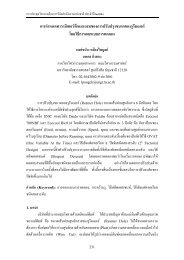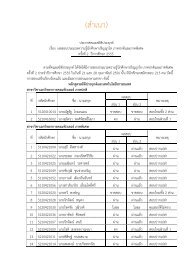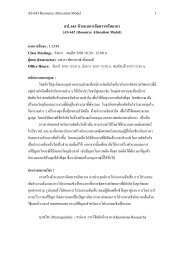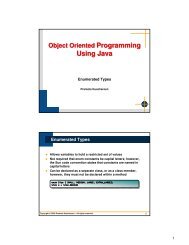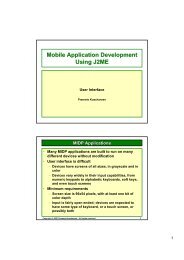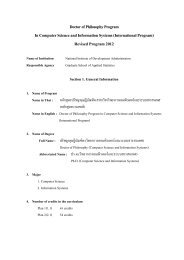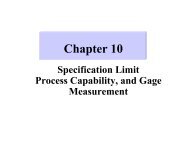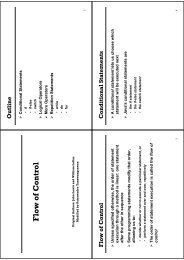ดาวน์โหลด All Proceeding - AS Nida
ดาวน์โหลด All Proceeding - AS Nida
ดาวน์โหลด All Proceeding - AS Nida
Create successful ePaper yourself
Turn your PDF publications into a flip-book with our unique Google optimized e-Paper software.
The next step was the statistical analysis of reliability data<br />
(time to failure) of the critical components and the assessment of the<br />
probability density functions (pdf) of time to failure distributions.<br />
4.4 Failure Data Analysis<br />
Reliability Parameters Estimation – Failure and<br />
maintenance data of the plant was collected from the maintenance log<br />
book. The related data were used to obtain failure and repair rates of the<br />
major components associated with the paper production unit of the<br />
244<br />
plant. In this study, Weibull distribution has been used to represent<br />
equipment failure time. The shape parameter (β) and scale parameter<br />
(η) of the Weibull distribution have been computed using least square<br />
curve fitting technique. At this stage the statistical software was used in<br />
order to conduct the statistical analysis, and the Kolmogorov-Smirnov<br />
(K-S Test) goodness of fit test was used in order to ensure a good pdf<br />
fitting to the data. Table 7 shows a sample of some results.<br />
Table 7 Reliability Parameters Estimation & Goodness of Fit Test<br />
Component<br />
Parameters<br />
β η<br />
Correlation<br />
Coefficient<br />
K-S Test (α = 0.05, n = 21)<br />
max d dα<br />
Test Results<br />
1. Motor 1.42682 62.6639 0.972 0.2177 0.287 Accept<br />
2. Belt 1.37027 23.5603 0.918 0.1902 0.287 Accept<br />
3. Shaft & Shaft sleeve 1.12241 26.0567 0.984 0.1518 0.287 Accept<br />
4. Pump bearings 5.26308 10.2572 0.963 0.1971 0.287 Accept<br />
5. Motor bearings 1.20565 56.2784 0.969 0.2282 0.287 Accept<br />
6. Packing 5.49178 3.86463 0.970 0.1958 0.287 Accept<br />
7. Flange 1.42214 15.9930 0.988 0.1630 0.287 Accept<br />
8. Impeller 1.30804 111.277 0.982 0.1847 0.287 Accept<br />
9. Body 1.18374 113.604 0.978 0.1905 0.287 Accept<br />
10. Pulley 1.01427 82.1241 0.972 0.2019 0.287 Accept<br />
11. Pump base 1.01035 137.051 0.987 0.1864 0.287 Accept<br />
Since a distribution closed to the data so it can be a<br />
parameter β (Shape parameter) and η (Scale parameter) used to<br />
analysis and selection of maintenance tasks.<br />
4.5 Maintenance Task Analysis and Selection<br />
Once failure mode and reliability parameters have been<br />
identified, the next step is to analyze and provide the applicability of<br />
maintenance task by using these principles:<br />
1. Task selection for β ~ 1 (almost Exponential), PM was<br />
selected to machines with a constant failure rate. The Optimal<br />
inspection interval for component parts and interval is called the failurefinding<br />
interval (FFI) which is the mean time to fail (MTTF or η)<br />
applies as a guideline such as motors have the MTTF is 62.6639 weeks,<br />
thus the FFI for motor at 60 weeks or 15 months. Table 8 provides the<br />
expected availability obtained from different FFIs.<br />
Table 8 Failure Finding Interval (FFI)<br />
Component<br />
Parameters<br />
β η<br />
FFI<br />
(months)<br />
1. Motor 1.42682 62.6639 15<br />
2. Belt 1.37027 23.5603 5<br />
3. Shaft & Shaft sleeve 1.12241 26.0567 6<br />
4. Pump bearings 5.26308 10.2572 -<br />
5. Motor bearings 1.20565 56.2784 14<br />
6. Packing 5.49178 3.86463 -<br />
7. Flange 1.42214 15.9930 3<br />
8. Impeller 1.30804 111.277 27<br />
9. Body 1.18374 113.604 28<br />
10. Pulley 1.01427 82.1241 20<br />
11. Pump base 1.01035 137.051 34<br />
2. Task selection for > 1, PdM was selected to machines with a<br />
increasing failure rate. Determination of maintenance intervals in this<br />
section is to determine the best times at which replacements should<br />
occur to minimize total downtime per unit time. The total downtime per




